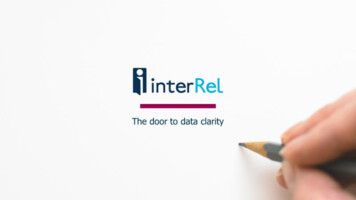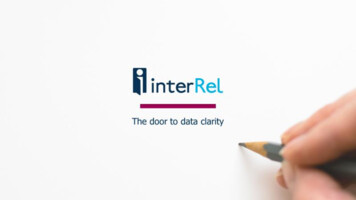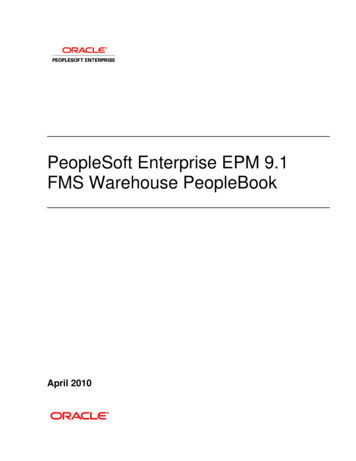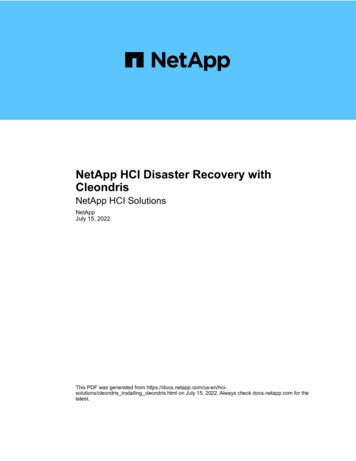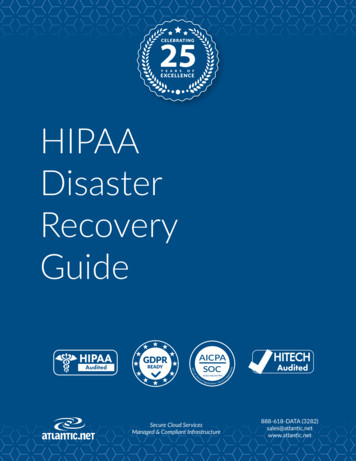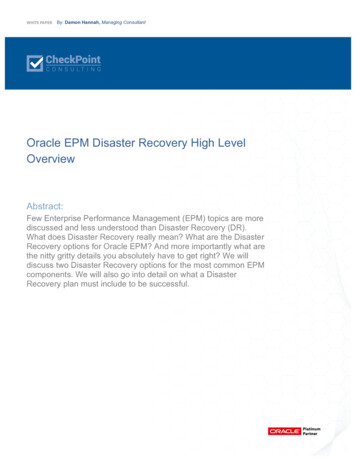
Transcription
12By: Damon Hannah, Managing ConsultantOracle EPM Disaster Recovery High LevelOverviewAbstract:Few Enterprise Performance Management (EPM) topics are morediscussed and less understood than Disaster Recovery (DR).What does Disaster Recovery really mean? What are the DisasterRecovery options for Oracle EPM? And more importantly what arethe nitty gritty details you absolutely have to get right? We willdiscuss two Disaster Recovery options for the most common EPMcomponents. We will also go into detail on what a DisasterRecovery plan must include to be successful.
Oracle EPM Disaster Recovery High Level OverviewWhat is Disaster Recovery?What does ‘Disaster Recovery’ really mean? Disaster Recovery is a nebulous term that can be used todescribe or define any number of scenarios or situations. DR is defined by Dictionary.com as “Planningand implementation of procedures and facilities for use when essential systems are not available for aperiod of time long enough to have a significant impact on the business ” That definition is moderatelyhelpful, except that it still leaves a great deal open to interpretation. What constitutes ‘ a significantimpact on the business’ and more importantly who decides for your organization?Oracle’s documentation outlines the following purpose for a Disaster Recovery; “Addresses servicecontinuity so that in case of a disaster, service is maintained through a standby site”. This begs thequestion; what constitutes a disaster? In the end each organization or business must decide for itselfwhat constitutes a ‘disaster’, and who within the organization decides when one has occurred.Your organization may have a more relaxed view of Disaster Recovery and may intend to initiate afailover plan in the event of performance issues, server failures, network issues, or other unplannedoutages. While Disaster Recovery plans can be customized to meet these needs, they can also bemitigated using Fault Tolerant (FT) and Highly Available (HA) solutions.For the purposes of this document, a ‘disaster’ is defined as anything that results in a site-wide failure ofthe primary Data Center. Therefore, Disaster Recovery is the processes and procedures necessary torestore essential systems (Oracle EPM for our purposes) in the event of a site-wide failure of the primaryData Center.Disaster Recovery OptionsThere are an unlimited number of options for setting up a Disaster Recovery plan for an EPM 11.1.2.3environment. They span the field from a simple export/import of your primary EPM application to anotherenvironment, to a full replication of Production to a dedicated Disaster Recovery environment. Many ofthe EPM components have similar recovery requirements or options. However, there are some EPMcomponents with unique recovery requirements. Understanding these is paramount to a successful DRplan.Putting Together a Disaster Recovery SolutionThe critical first step is Requirements Gathering, which identifies the specific requirements for DisasterRecovery. Without requirements, it is impossible to properly design a DR solution. Once requirementsare agreed upon, the method used for recovery is identified; replicating the Production Servers in a DRenvironment, repurposing another environment as the DR environment, or another custom solution canbe determined. A detailed plan must then be created to meet every requirement identified; backups,schedule and method of backups, retention plans for backups, storage and replication of backups to theDR site, and owner of each backup, etc. When the backup plan is complete, it must be implemented,independently verified, and documented.When the backups are in place and documented, a Recovery Plan should be thought out, documented,and any prerequisite pieces put in place (such as creating Essbase applications in the Targetenvironment). A step-by-step recovery guide should then be created. The guide will include a High Level2p.
Oracle EPM Disaster Recovery High Level OverviewChecklist - complete with task ownership, overseeing identification, and verification steps. A detailedprocess for each High Level Task should be included with step-by-step directions for completing eachtask. These steps should be executable by anyone familiar with Oracle EPM Systems but with zeroenvironment specific knowledge. Finally, verification/validation testing should be documented, includingtesting owners and pass/fail qualifications.Once the proper documentation, backups, and processes are in place, a failover test should beexecuted. The initial test should focus on documentation accuracy and a successful failover from anInfrastructure Perspective. Application availability and 100% functionality should be verified; howeverdata is not a critical part of this initial test. Following a successful infrastructure test, a failover testincluding data validation and end-to-end testing should be conducted.During all tests, the DR Failover documentation should be followed step-by-step. Any discrepanciesshould be noted and documentation updated. This will ensure subsequent tests are successfulregardless of the parties involved.Dedicated Disaster Recovery EnvironmentNow that we have looked at the different EPM components and their recovery requirements, let us lookat a couple of ways to put them all together. First up is a dedicated DR environment solution. In thisexample, the DR Environment was installed and configured following the same steps that were used tobuild the Production EPM environment. The server and RDBMS entries were configured using theProduction instance names; local host aliases were used to ensure all entries were resolved to the DRcomponents. We will then look at a custom solution that repurposes a Quality Assurance (QA)environment as a DR solution. This solution makes less use of replication and tends to be morecomplicated. It does however have the benefit of being less expensive, usually!This first example is an EPM 11.1.2.3 implementation. The DR environment was built by repeating thesteps used to install and configure the Production environment. Prior to configuring the DR environment,local host aliases were created on each of the servers, mapping the Production server names and DRserver names to the DR server IP addresses. This ensured the EPM configurations could use theProduction server names and eliminate a mismatch within the replicated Oracle schemas.The Production applications must be migrated to the DR environment to ‘seed’ the environment. Oncethe DR environment is seeded, replication and other processes are put in place to ensure the RPO andRTO requirements can be met. For example, command scripts are used to take nightly LCM exports ofShared Services, Planning applications, and Native Essbase applications. Shell scripts are used to takeLevel 0 data exports of all Essbase applications. All exports are stored on either NAS or SAN, which isreplicated to the DR environment.Repurposed Disaster Recovery EnvironmentThis example is of an EPM 11.1.2.3 implementation. The plan is based on repurposing the QualityAssurance (QA) environment as the Production environment in the event of a DR. The existing QAapplications, security, and data are not critical. While efforts will be made to back up the QA objects aspart of the failover, their survival is not paramount. The Recovery Point Objective (RPO) and RecoveryTime Objective are (RPO: HFM 0, Planning/Essbase 24 hours)(RTO 8 hours). The Recovery Time3p.
Oracle EPM Disaster Recovery High Level OverviewObjective is impacted by a number of items beyond the control of the Oracle EPM Team. Some of theseinclude network services, database services, Domain Name Services, and LDAP/MSAD authenticationservices. The RTO assumes all of these ‘required’ services are available and does not take into accountthe time required to restore those services. Limiting its dependencies on these other teams, especiallyDBAs can help make the DR plan or strategy more efficient when the time comes.The QA environment was architected to mirror the Production environment and it consists of the samenumber, size, and configuration of servers. The EPM installation and configuration also mirrors that ofProduction. However, the instance names, dBs, server names, etc. are all unique to the QAenvironment. The DR Solution is based on migrating the required objects from Production to QA (DR) inthe event of a disaster. The key being that the ‘export’ portion of the migration must be done prior to theProduction environment being lost due to a disaster. Each EPM component is taken individually toensure its export migration requirements are met. Those steps are then scripted through batch and shellscripts, and automated through third party tools. The import portion of the migrations is primarily amanual effort, although automating some of the pieces should be possible.The Life Cycle Management utility is the primary tool used for creating the required backups or migrationexports needed for DR. LCM export migrations are created for Planning, HFM, as well as Essbaseapplications and EPM System Security from the Production environment. These are stored on a NASthat is replicated to the QA environment.A weekly process is run to take cold backups of the entire Essbase volume, including all Essbaseapplication objects, configuration files, and the Essbase.sec (security) file. These Essbase backups andexports are stored on SAN which is replicated to the QA environment.In the event of a DR failover, the exported content is imported using the same method or tool used forthe export. When all objects have been imported, base level functionality testing is completed. Thisincludes a Health Check checklist that ensures basic functionality is working. HFM andPlanning/Essbase financial reports are executed to validate security, data source connectivity, HFM andPlanning/Essbase functionality, and Foundation and RA Services are working as expected. Followingthe base level testing, the application owners begin data validation testing. This includes a deeper diveinto the full EPM functionality and data validation. This level of testing closely resembles SystemsIntegration Testing (SIT) to ensure data flows through the entire system properly.Critical DetailsThere are many steps in designing and implementing an Oracle EPM Disaster Recovery solution; fromchoosing dedicated vs. shared environment, to using Life Cycle Management or RDBMS schemaexports. None of these is more important and critical to the success of the plan than requirementsgathering. Many times a disaster recovery solution is developed without ever having consulted thebusiness or application owners to identify or understand the actual requirements. Are all Productionapplications required in a DR scenario? What level of resiliency is necessary in a DR environment? Willthe upstream and downstream systems change? Will integrations change in DR? Will a full complementof users access the system in a DR scenario? What are the actual Recovery Point Objective (RPO) andRecovery Time Objective (RTO)? And what costs are you willing to accept to meet those requirements?Many of these questions are never asked or not fully answered or understood; by one or both sides. Forexample, an application owner that insists on an RPO of zero (zero data loss) for an Essbaseapplication, likely doesn’t understand the implications in terms of downtime to meet this ‘requirement’.4p.
Oracle EPM Disaster Recovery High Level OverviewThe requirements must be gathered and challenged to ensure 1) that they are truly ‘requirements’ and 2)that the costs for meeting the requirements are understood.Another critical piece is the backup strategy employed to meet the Recovery Point Objective. Many EPMcomponents can be properly and easily backed up using the Life Cycle Management’s command linerdutility. LCM migrations can be scripted using the LCM GUI and automated using 3 party schedulingtools. Most LCM migrations can be run during normal business processes with little or no impact to theend user. They can be scheduled to run as often as necessary to meet defined RPOs.The use of replication goes hand in hand with a proper backup methodology. Configuring the EPMcomponents to use NAS or SAN simplifies replicating the data to the Disaster Recovery environment.Lastly, once the DR plan is documented and implemented, it must be tested. Sometimes, the plan mustbe tested repeatedly to ensure the process, as documented is complete, accurate, and meets the DRrequirements. The test should be executed by the individuals tasked with executing the plan in a trueDisaster Recovery scenario. The plan should be followed step-by-step to ensure there are no actions orinformation assumed. This is to ensure the team can complete the test in the time allowed. Updates tothe DR plan are typically required during the first few tests. In the end, the plan should be able to be fullyexecuted by individuals outside of the design team, without assistance.5p.
There are an unlimited number of options for setting up a Disaster Recovery plan for an EPM 11.1.2.3 environment. They span the field from a simple export/import of your primary EPM application to another . There are many steps in designing and implementing an Oracle EPM Disaster Recovery solution; from choosing dedicated vs. shared .
